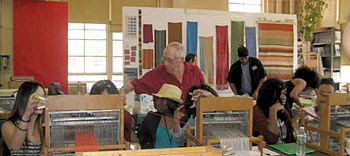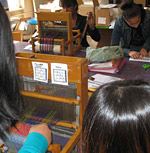
|
 |
OUTREACH
How We Came to Teach Weaving at
The High School for Fashion Industries in NY
Our First Day
In January 2002 Kate Boulamaali, Assistant Principal
High School of Fashion Industries contacted the
NYGH to find someone to evaluate a "big
loom" that had stood for years in one or her
classrooms. The loom stood unused and she
wanted to know if it could be made to work. We
made an appointment in February. It turned out
to be an old AVL dobby loom with sixteen
shafts. Now, we have brought looms back to life
before but never a dobby. As it was beyond our
abilities so we made some suggestions of people
to contact.
 Then Kate said "Oh but I have more." She took
us to her storage area and there on shelves
stacked sometimes, three high, were 15 inch and
21inch Dorothy looms. There must have been at
least twenty-five. Most were four shaft looms
with a few eight shaft ones thrown in. We started
taking them down from the shelves only to find
that all were missing bolts, screws, reeds, aprons,
tie on rods, tops and bottoms of beaters and
most of the harnesses were hanging free. So we
made a date to go back and do an evaluation.
Kate is enthusiastic about
getting weaving going again
at HSFI. We talked about
weaving and using the
Dorothys and before we knew
it, she asked us if we could
put together an intro weaving
class. Originally it was to be
an after school class of 6 or 8 students but it
quickly morphed into the 10th grade (108 students)
during school hours. Kate decided that
the best arrangement would be to divide the
10th grade into four sections, with two students
working on a loom, and each section would have
two sessions. The total time for the two sessions
would be two and quarter hours. Not much time
but it would be good for them to try weaving on
a loom as opposed to just weaving with paper
which they had been doing.
Then Kate said "Oh but I have more." She took
us to her storage area and there on shelves
stacked sometimes, three high, were 15 inch and
21inch Dorothy looms. There must have been at
least twenty-five. Most were four shaft looms
with a few eight shaft ones thrown in. We started
taking them down from the shelves only to find
that all were missing bolts, screws, reeds, aprons,
tie on rods, tops and bottoms of beaters and
most of the harnesses were hanging free. So we
made a date to go back and do an evaluation.
Kate is enthusiastic about
getting weaving going again
at HSFI. We talked about
weaving and using the
Dorothys and before we knew
it, she asked us if we could
put together an intro weaving
class. Originally it was to be
an after school class of 6 or 8 students but it
quickly morphed into the 10th grade (108 students)
during school hours. Kate decided that
the best arrangement would be to divide the
10th grade into four sections, with two students
working on a loom, and each section would have
two sessions. The total time for the two sessions
would be two and quarter hours. Not much time
but it would be good for them to try weaving on
a loom as opposed to just weaving with paper
which they had been doing.
The Second Day
On our assessment trip we estimated that thirteen
of the 15" Dorothys could be put in working
order. We didn't check out the 8 harness
Dorothys. We looked over the yarn that they
had sitting around and found it was very, very
fine and color wise it looked about fifteen year
sold. While looking for yarn in one of the closets
we spotted a shape we both know well, but it
was buried behind a lot of "stuff ". Later it was
moved into our workroom and, indeed, it was a
40" eight shaft Macomber but it was in sad
shape with broken treadles and missing rocker
pins for the beater and that was just for starters.
Many Days
Over the next few weeks we went to the school
with armed with tools, Murphy's Wood Soap,
and a large can of WD40. We learned a lot
about the Dorothy loom! A few of them had
been put together incorrectly. Getting them all
to work took creative tweaking and just plain
hard work. We made many trips to the hard
ware store for
more bolts and
wing nuts.
We decided to
have the looms
warped and ready
for the students to
weave on. The
yarns from the
High School were OK for weft if doubled so we
dug into our stash and came up with yarns in a
variety of colors. We wound fifteen 6 inch wide
3.5 yard long warps. It could have been worse
they might have been 36 inches wide! The looms
were threaded for Rose path, Birds Eye, Finnish
Twill and plain draw but all would weave plain
weave and twill. All the reeds were 15 EPI, but we
used a 12 EPI sett on most. This was one heck of
a job. We went home exhausted after each session.
A More realistic title
In the end it was decided to call this "A Taste of
Weaving" because we couldn't teach the whole
process. It couldn't be "Beginning Weaving" or
even "Intro to Weaving". There was just not
enough time to cover even the basics of the process.
 First Class
First Class
The first class went well. We gave a very brief
PowerPoint presentation with weaving terms, a
picture of loom with labeled parts, and pictures
of how to throw shuttle and beat. Some the students
got this pretty fast.
One student would read the treading sequence
and lifted the shafts and the other would throw
the shuttle and beat in the weft. We let them
decide when they would trade roles. The first
exercise was plain weave. Halfway through the
class we switched to weaving a 2/2 twill. Before
the end we asked everyone to stop and walk
around to see what all the others had woven.
End of session one. Whew!!
Second Class
At the next session they wove
Rose Path, Birds Eye, Finish
Twill and Broken Twill on the
plain draw. They had a choice
of weft thread and made
some fearless choices that
really turned out to be quite wonderful. Twice we
asked them to move down two looms and continuing
weaving on that loom. There is nothing like
stirring things up a bit.
At the end of the second session it was clear that
some of the kids were really hooked. One even
asked if they could form an after school club to
do this (yea!). You could see that some of the
students "got it". It was like a light went on.
Others, alas, never got to that stage but we hope
there was some appreciation of what the creation
of woven textiles involved.
We had a lot of fun and it was rewarding to see
how many students become really involved in
what they were creating on their looms.


|
 |

